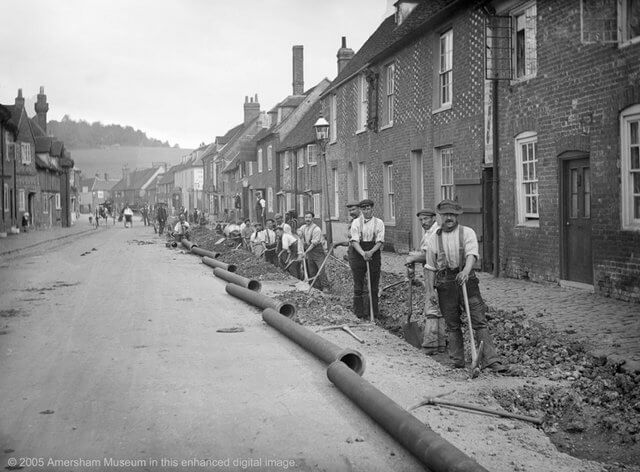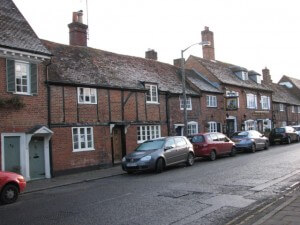Nos. 30 (Jabula House) and 30A (The Old Bread Shop). The numbering of these two houses (which only dates back to 1952) implies that they were once one house which was subsequently sub-divided. This is true – but only after they were separate houses which had then been combined. The history of these two houses is intimately connected!
Both houses date back at least to the 17th century, possibly earlier. Both are timber-framed buildings, although later modernised, probably in Georgian times, by hiding the timbers behind a brick front (no. 30) or by filling the spaces between the timbers with bricks (no. 30A). In 1694, no. 30 was assessed for Land Tax at 6 shillings (£0.30) whereas no. 30A was only assessed at 4 shillings (£0.20). At the time, both houses were owned by William Browne, although he was probably not occupying either. They passed to his daughter-in-law Susanna Norwood and then to her daughter Susanna Wingrove. No. 30 was rented to Richard Norwood and later (1742) to James Harding and his wife Sarah. According to the 1742 Tithe Map the occupant of no. 30A was William Bull.
Both houses were sold to Elizabeth Batchelder and by 1755 no. 30 was occupied by John Charsley, ‘a gentleman’. Elizabeth lived next door at no. 30A with her nephew William Batchelder. She died in 1762 and ‘desired to be buried amongst the Quakers’. In her will she left the houses to her nephew, William, and he died in 1779. In his will he left £40 to his wife Sarah (& £20 to his maid servant!) and he appointed 2 executors who were supposed sell all his Whielden Street properties (nos. 30, 30A and 32) and invest the money, with the interest to be paid to his wife Sarah until her death and then the investment was to be divided amongst various nephews and nieces. This did not happen until Sarah’s death in 1801, after which the three houses were sold by auction at The Crown in 1803 to William Weller. He was the brewer who owned the Saracen’s Head, the maltings and the brewery near the Church. The houses then passed to Thomas Drake Tyrwhitt Drake, the Lord of the Manor.
Various people rented no. 30 over the years but it was often unoccupied following the death of the tenant: Mr Packer had been there in 1783, Mr Pemberton in 1786, John Norris in 1789/90, John Hewitt in 1793, John Steventon 1794/96, Benjamin Child 1797/1802. Arthur Redding married Fanny Child in 1803 and moved into no. 30. Fanny was still there in 1841. Charles Butcher was a baker living there in 1851, having moved from next door (30A), probably continuing to use the same bake house in the yard at the back. Charles Butcher was related to the Reddings and, like his wife Catherine, had been born in Coleshill (then in Hertfordshire).
Land Tax records show Sarah Batchelder moved out of no. 30A in 1794, renting the house to John Jemmitt until 1796, when he died. It was then vacant until 1799 when James Butcher rented it. In the 1841 census there was a bakery there run by Charles Butcher (James’s son) but by 1851 Charles had moved next door to no. 30 and Thomas Woodbridge, a tailor, was living at 30A.
By 1861 nos. 30 and 30A were being run as one household and business with Henry Gurney as the baker and the Gurney family were still bakers there in 1911. After the death of Henry Gurney in 1875 his wife Mary Ann Jane and one of his sons, James Richard, took over the business which seems to have been prosperous, as over the years they employed various assistants and servants. In 1911 it was all one household, with the census recording 12 rooms including kitchens, but excluding lobbies, landings, hallways, warehouses, offices and shops.
In the 1928 auction of houses throughout the Old Town by the Tyrwhitt-Drake estate, nos. 30 and 30A were sold as one property for £775. It was described as ‘extensive premises let to William Henry Snell on a rent of £50 per annum’, with a total area in all of about 28 poles. The sale details were:
1. House adjoining and semi-detached (at present let off), Sitting Room, Kitchen, Two Bedrooms.
2. Shop, Office, Sitting Room, Kitchen and Scullery, Drawing Room, upstairs, Three Bed Rooms, One Box Room, One Attic.
Cart Shed, Stabling (Three Stalls), Garage, Bake House with Flour Loft over.
William Snell’s wife Mary was the daughter of Joseph Hatch. William had been a baker in Ealing but when he married Mary, Joseph set him up in business in Whielden Street.
By 1939, according to the national register taken at the outbreak of the 2nd World War, the houses were clearly sub-divided. Hardwick H. Barnes, a general labourer, and his wife Florence May Barnes, were living at no. 30. The Snell family, comprising William, his wife Mary Anne and their two sons Stuart William (a cinema projectionist) and Gerald Frederick (a baker) occupied 30A. William Snell died in 1948 and his sons carried on the business until the early 1950s, still delivering bread in wicker baskets. It was later a bread shop, Beaconsfield Bakery, until the 1970s, run by Mrs Phyllis Sibley. The Sibley family used to operate the flour mill (Town Mill or Sibley’s Mill) in Mill Lane. In the 1980s the situation reverted to what it had been in the 18th century when the two houses were completely separated, and the bake house at the rear was converted into a third house, and all three were sold off separately.
(The above article was written and researched by Peter Borrows)
Troye Cottage, 32 Whielden Street
A very interesting and detailed article written by the owners about this cottage appears as a separate “House History Detective” page.
No. 34 (Bottle Cottage) and No. 36 These are again listed grade II buildings. No. 34 is thought to be 17th century but subsequently altered. No. 36 is thought to have been re-fronted in the 18th century. The inhabitants of no. 34 between 1841 and 1911 were a tailor, a chairmaker, a messenger, a police officer, a carpenter and a plumber.
The building next to no. 36 was part of The Saracen’s Head and, as the photos below show, was a shop for some years. In about 1890 it was John Neal’s grocery stores and in the archway next door is a man selling soap. The man with the barrow in front is probably Frederick Stromwell, a costermonger (fruit seller) who lived at the Saracen’s Head. By 1892 it was another grocery shop (“The cheapest ready money tea grocery provision warehouse” it says on the notice), and Edward Scott’s butchers shop by 1895, by then incorporating the carriageway entrance to the Saracen’s Head.
No. 38 (The Saracen’s Head) is another listed building, probably 18th century. The public house used to be at 16-22 The Broadway but moved in the early 1700s (see research paper). A local newspaper reported in 1901 that the pub was used for “The Amersham Palace of Varieties” and that Professor Wright “not only has his marvellous performing dog, Lulu, but has engaged several good singers who greatly add to the entertainment”! The pub was sold by Weller’s Brewery in 1929 and at that time was tenanted by Mr H Tasker, who paid an annual rent of £25. See a more detailed article written by the Amersham Society.
Are there ghosts in The Saracens Head? It is said that two ghosts have been seen, one a young serving girl from the 1600s.
Click on any of the photographs below to enlarge it and to see the description. Then click on forward or back arrows at the foot of each photograph. To close the pictures, just click on one.








